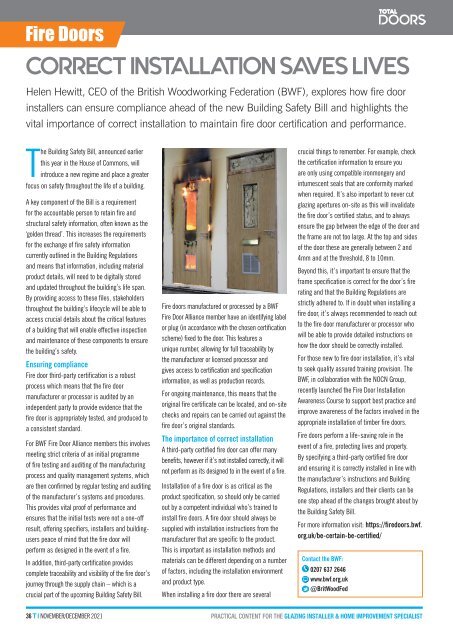November/December 2021
Create successful ePaper yourself
Turn your PDF publications into a flip-book with our unique Google optimized e-Paper software.
Fire Doors<br />
CORRECT INSTALLATION SAVES LIVES<br />
Helen Hewitt, CEO of the British Woodworking Federation (BWF), explores how fire door<br />
installers can ensure compliance ahead of the new Building Safety Bill and highlights the<br />
vital importance of correct installation to maintain fire door certification and performance.<br />
The Building Safety Bill, announced earlier<br />
this year in the House of Commons, will<br />
introduce a new regime and place a greater<br />
focus on safety throughout the life of a building.<br />
A key component of the Bill is a requirement<br />
for the accountable person to retain fire and<br />
structural safety information, often known as the<br />
‘golden thread’. This increases the requirements<br />
for the exchange of fire safety information<br />
currently outlined in the Building Regulations<br />
and means that information, including material<br />
product details, will need to be digitally stored<br />
and updated throughout the building’s life span.<br />
By providing access to these files, stakeholders<br />
throughout the building’s lifecycle will be able to<br />
access crucial details about the critical features<br />
of a building that will enable effective inspection<br />
and maintenance of these components to ensure<br />
the building’s safety.<br />
Ensuring compliance<br />
Fire door third-party certification is a robust<br />
process which means that the fire door<br />
manufacturer or processor is audited by an<br />
independent party to provide evidence that the<br />
fire door is appropriately tested, and produced to<br />
a consistent standard.<br />
For BWF Fire Door Alliance members this involves<br />
meeting strict criteria of an initial programme<br />
of fire testing and auditing of the manufacturing<br />
process and quality management systems, which<br />
are then confirmed by regular testing and auditing<br />
of the manufacturer’s systems and procedures.<br />
This provides vital proof of performance and<br />
ensures that the initial tests were not a one-off<br />
result, offering specifiers, installers and buildingusers<br />
peace of mind that the fire door will<br />
perform as designed in the event of a fire.<br />
In addition, third-party certification provides<br />
complete traceability and visibility of the fire door’s<br />
journey through the supply chain – which is a<br />
crucial part of the upcoming Building Safety Bill.<br />
Fire doors manufactured or processed by a BWF<br />
Fire Door Alliance member have an identifying label<br />
or plug (in accordance with the chosen certification<br />
scheme) fixed to the door. This features a<br />
unique number, allowing for full traceability by<br />
the manufacturer or licensed processor and<br />
gives access to certification and specification<br />
information, as well as production records.<br />
For ongoing maintenance, this means that the<br />
original fire certificate can be located, and on-site<br />
checks and repairs can be carried out against the<br />
fire door’s original standards.<br />
The importance of correct installation<br />
A third-party certified fire door can offer many<br />
benefits, however if it’s not installed correctly, it will<br />
not perform as its designed to in the event of a fire.<br />
Installation of a fire door is as critical as the<br />
product specification, so should only be carried<br />
out by a competent individual who’s trained to<br />
install fire doors. A fire door should always be<br />
supplied with installation instructions from the<br />
manufacturer that are specific to the product.<br />
This is important as installation methods and<br />
materials can be different depending on a number<br />
of factors, including the installation environment<br />
and product type.<br />
When installing a fire door there are several<br />
crucial things to remember. For example, check<br />
the certification information to ensure you<br />
are only using compatible ironmongery and<br />
intumescent seals that are conformity marked<br />
when required. It’s also important to never cut<br />
glazing apertures on-site as this will invalidate<br />
the fire door’s certified status, and to always<br />
ensure the gap between the edge of the door and<br />
the frame are not too large. At the top and sides<br />
of the door these are generally between 2 and<br />
4mm and at the threshold, 8 to 10mm.<br />
Beyond this, it’s important to ensure that the<br />
frame specification is correct for the door’s fire<br />
rating and that the Building Regulations are<br />
strictly adhered to. If in doubt when installing a<br />
fire door, it’s always recommended to reach out<br />
to the fire door manufacturer or processor who<br />
will be able to provide detailed instructions on<br />
how the door should be correctly installed.<br />
For those new to fire door installation, it’s vital<br />
to seek quality assured training provision. The<br />
BWF, in collaboration with the NOCN Group,<br />
recently launched the Fire Door Installation<br />
Awareness Course to support best practice and<br />
improve awareness of the factors involved in the<br />
appropriate installation of timber fire doors.<br />
Fire doors perform a life-saving role in the<br />
event of a fire, protecting lives and property.<br />
By specifying a third-party certified fire door<br />
and ensuring it is correctly installed in line with<br />
the manufacturer’s instructions and Building<br />
Regulations, installers and their clients can be<br />
one step ahead of the changes brought about by<br />
the Building Safety Bill.<br />
For more information visit: https://firedoors.bwf.<br />
org.uk/be-certain-be-certified/<br />
Contact the BWF:<br />
0207 637 2646<br />
www.bwf.org.uk<br />
@BritWoodFed<br />
36 T I NOVEMBER/DECEMBER <strong>2021</strong><br />
PRACTICAL CONTENT FOR THE GLAZING INSTALLER & HOME IMPROVEMENT SPECIALIST

















